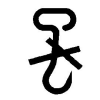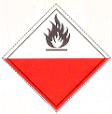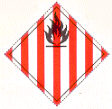| Absorbent cotton | [German version] |
Table of contents |
|
| General: | ||
| Product information | ||
| Packaging | ||
| Transport | ||
| Container transport | ||
| Cargo securing | ||
Product information
Product name
| German | Watte |
| English | Absorbent cotton, wadding |
| French | Ouate |
| Spanish | Algodón |
| Scientific | Gossypium hirsutum |
| CN/HS number * | 56 ff. |
(* EU Combined Nomenclature/Harmonized System)
Product description
Absorbent cotton is obtained from degreased and bleached short, very loose, soft cotton fibers or viscose staple fiber. The fibrous material is in part broken down to the individual fibers, which naturally adhere together.
Absorbent cotton for medical dressings consists of nonwoven fleeces of fine, roughly parallel, knot-free cotton fibers, up to 3 cm in length, made from spinning mill waste (comber waste). It is sterile and is therefore suitable for use in dressings.
Quality / Duration of storage
Do not accept for loading absorbent cotton which is wet, damp, contaminated or discolored.
Subject to compliance with the appropriate temperature and humidity/moisture conditions, duration of storage is not a limiting factor as regards transport and storage life.
Intended use
Absorbent cotton is used to produce dressing material, padding for items of clothing, quilts etc..
Figure
(Click on the individual Figures to enlarge them.)
 Figure 1 |
Countries of origin
This Table shows only a selection of the most important countries of origin and should not be thought of as exhaustive.
| Europe | Bulgaria, Spain, Russia, Turkey |
| Africa | Egypt, Ivory Coast, Mali, Burkina Faso, South Africa, Sudan, Chad, Zimbabwe, Ethiopia, Algeria, Uganda |
| Asia | Burma, India, Pakistan, China, Iraq, Syria, Afghanistan, Iran |
| America | El Salvador, Guatemala, Mexico, Nicaragua, USA, Honduras, Argentina, Brazil, Venezuela |
| Australia |
Back to beginning
Packaging
Absorbent cotton is transported in bales, which are strapped with metal strapping and wrapped in jute fabric.
| Marking of packages | ||
 Keep dry |
 Use no hooks |
 Keep away from heat (solar radiation) |
Back to beginning
Transport
Symbols
 Spontaneously combustible, Class 4.2 IMDG Code |
 Fire hazard (Flammable solids), Class 4.1 IMDG Code |
 General cargo |
Means of transport
Ship, truck, railroad
Container transport
Standard containers , subject to compliance with water content of goods, packaging and flooring.
Cargo handling
In damp weather (rain, snow), the cargo must be protected from moisture, since absorbent cotton is strongly hygroscopic and readily absorbs moisture. This may lead to discoloration, decay, mold, mildew stains and rot. In addition, the absorbent cotton may swell by absorbing water vapor, resulting in an increase in volume of 40 – 45%.
Do not use hooks for cargo handling, since they may lead to sparking when they come into contact with metal objects.
In addition, smoking is absolutely prohibited during cargo handling.
Stowage factor
| 7.31 m3/t (bales) [1] |
Stowage space requirements
dry
Segregation
Fiber rope, thin fiber nets
Cargo securing
The cargo is to be secured in such a way that the bales or strapping are not damaged. Undamaged strapping is essential to maintain compression of the bales during transport. If the strapping is broken, compression is diminished, which at the same time results in an increased supply of oxygen to the inside of the bales. This in turn increases the risk of combustion or feeds a fire which has already started. Bursting or chafing of metal straps may lead to sparking and external ignition.
Back to beginning
Risk factors and loss prevention
RF Temperature
Absorbent cotton requires particular temperature, humidity/moisture and possibly ventilation conditions (SC VI) (storage climate conditions).
Favorable travel temperature range: no lower limit – 30°C
Back to beginning
RF Humidity/Moisture
Absorbent cotton requires particular temperature, humidity/moisture and possibly ventilation conditions (SC VI) (storage climate conditions).
| Designation | Humidity/water content | Source |
| Relative humidity | 65% | [1] |
| Water content | 7.85 – 8.5% | [1] |
| Maximum equilibrium moisture content | 70% | [1] |
Being strongly hygroscopic (hygroscopicity), absorbent cotton readily absorbs all types of moisture. It must be protected from sea, rain and condensation water and also from high levels of relative humidity, if decay, discoloration, mold, mildew stains and rot are to be avoided.
In addition, the absorbent cotton may swell by absorbing water vapor, resulting in an increase in volume of 40 – 45%.
Back to beginning
RF Ventilation
Absorbent cotton requires particular temperature, humidity/moisture and possibly ventilation conditions (SC VI) (storage climate conditions).
If the product is loaded for shipment in a dry state, it does not have any particular ventilation requirements.
Problems arise if the product, packaging and/or ceiling/flooring are too damp. In this case, the following ventilation measures should be implemented:
air exchange rate: 6 changes/hour (airing)
Back to beginning
RF Biotic activity
Absorbent cotton displays 3rd order biotic activity.
It belongs to the class of goods in which respiration processes are suspended, but in which biochemical, microbial and other decomposition processes still proceed.
Back to beginning
RF Gases
The increase in CO2 and CO content indicates a cargo fire. The TLV of the hold air is 0.49 vol.%. As a result of the oxygen-rich lumen, bales often burn for weeks without being discovered. The high absorption capacity of the fibers means that the gaseous combustion products are soaked up by the cotton fibers and the smoke alarm is often triggered too late.
Back to beginning
RF Self-heating / Spontaneous combustion
Absorbent cotton is assigned to Class 4.1 of the IMDG Code (Flammable solids). However, its specific characteristics and negative external influences (see below) may cause it to behave like a substance from Class 4.2 (Substances liable to spontaneous combustion) of the IMDG Code or ADR.
Absorbent cotton is liable to catch fire through external ignition. Therefore, it must always be protected from sparks, fire, naked lights and lit cigarettes. Smoking is absolutely prohibited. Sparks may arise from bursting or chafing of the metal straps (and also as a result of inadequate cargo securing in the hold or container) and cause a cargo fire. In accordance with the IMDG Code, ventilation openings leading into the hold should be provided with spark-proof wire cloth.
Contamination with oils/fats may result in cargo fires.
Fire-fighting is best performed using CO2 . It is very difficult to extinguish a fire because of the excess of oxygen in the cotton fiber, which maintains the fire from the inside. When fighting a fire, do not break the metal straps or open the bales, since relieving the compression increases the oxygen supply and makes it impossible to fight the fire effectively.
Water must not be used for fire-fighting, since the swelling capacity of the absorbent cotton may cause damage to the hold or container walls.
Back to beginning
RF Odor
| Active behavior | Absorbent cotton is neutral in odor. |
| Passive behavior | Absorbent cotton is sensitive to all types of odor tainting. |
Back to beginning
RF Contamination
| Active behavior | Absorbent cotton does not cause contamination |
| Passive behavior | Absorbent cotton is sensitive to contamination by dust (coal, cement, dyes etc.), dirt, fats/oils and rust as well as oil-containing goods, such as oil-bearing seeds/fruits, copra, raw wool etc., since oil-impregnated fibers promote self-heating/cargo fire. Holds or containers must accordingly be clean and in a thoroughly hygienic condition. Rust contamination may be caused by rusty metal straps, among other things. |
Back to beginning
RF Mechanical influences
Absorbent cotton is sensitive to mechanical influences. Snapping, chafing and breaking of the steel strapping result in tearing of wrappings, losses of volume and contamination.
Back to beginning
RF Toxicity / Hazards to health
No risk.
Back to beginning
RF Shrinkage/Shortage
Unclearly marked bales may result in losses of volume due to incorrect delivery.
Back to beginning
RF Insect infestation / Diseases
No risk.
Back to beginning
